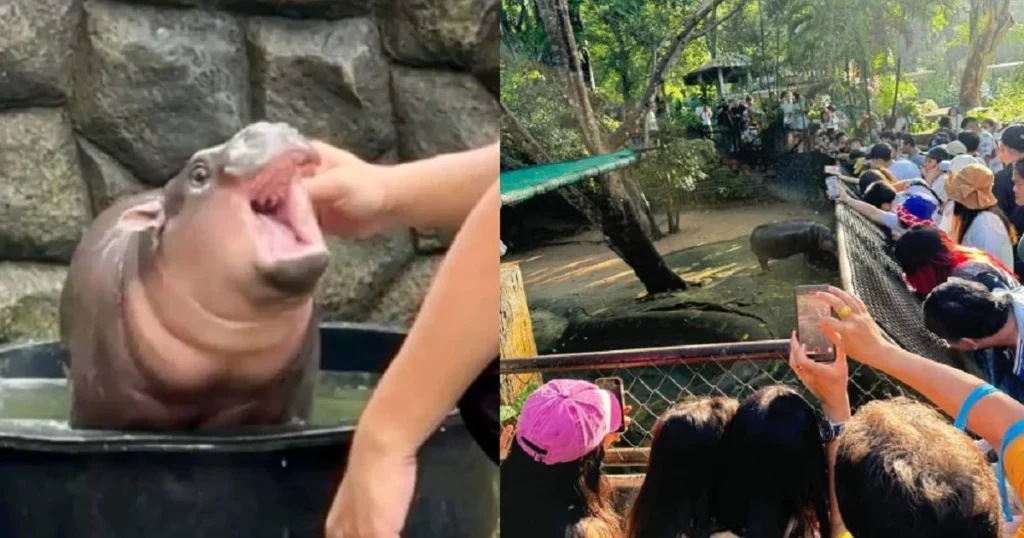baby pygmy hippopotamus: The animal kingdom is full of fascinating creatures, and among the most endearing is the baby pygmy hippopotamus. Often overshadowed by its larger cousin, the common hippo, the pygmy hippopotamus is a rare and unique animal that has captured the hearts of wildlife enthusiasts around the world.
The baby pygmy hippopotamus, in particular, is a sight to behold—small, adorable, and already well-equipped for life in the wild.
This article will explore everything you need to know about the baby pygmy hippopotamus, including its characteristics, habitat, behavior, and the conservation efforts in place to protect this vulnerable species.

What is a Pygmy Hippopotamus?
Before we dive into the specifics of the baby pygmy hippopotamus, it’s essential to understand what a pygmy hippopotamus is. The pygmy hippo (Choeropsis liberiensis) is native to the forests and swamps of West Africa, primarily Liberia, with smaller populations found in neighboring countries like Sierra Leone, Guinea, and the Ivory Coast.
Unlike the common hippopotamus, which lives in large groups near rivers and lakes, the pygmy hippopotamus is a solitary and more elusive creature. It is much smaller, standing about 2.5 to 3 feet tall at the shoulder and weighing around 400 to 600 pounds when fully grown. This is in stark contrast to the common hippo, which can weigh over 3,000 pounds.
The Adorable Baby Pygmy Hippopotamus
A baby pygmy hippopotamus is even more diminutive and utterly charming. At birth, a baby pygmy hippo weighs between 10 and 14 pounds, making it small enough to fit in your arms. Unlike many other large mammals, baby pygmy hippos are born nearly fully developed, with their eyes open and the ability to stand and walk shortly after birth.
Their skin is a glossy, dark gray to brown color, and like their larger relatives, it secretes a protective oil that acts as a natural sunscreen and moisturizer. This oil gives the baby pygmy hippopotamus its characteristic shiny, almost slippery appearance.
Behavior and Development of Baby Pygmy Hippopotamuses
During the first few months of life, a baby pygmy hippopotamus is highly dependent on its mother. It will nurse from her for several months, typically up to 6 to 8 months, while also gradually beginning to eat solid vegetation as it matures. Baby pygmy hippos are usually born in secluded areas, as the mother seeks privacy and protection from predators.
Although they are born capable of walking, baby pygmy hippos are not particularly strong swimmers right away. Unlike common hippos that give birth in water, pygmy hippos deliver their young on land. However, baby pygmy hippos quickly develop the ability to swim, using their webbed feet to propel themselves through the water as they learn to navigate the swamps and rivers of their habitat.
The baby pygmy hippopotamus is generally a quiet creature, though it will communicate with its mother through soft grunts and squeaks. Pygmy hippos are less vocal than common hippos, likely due to their more solitary lifestyle.
Habitat and Challenges in the Wild
The natural habitat of the pygmy hippopotamus is dense, swampy forests. These areas provide the necessary cover for the baby pygmy hippopotamus to hide from predators and explore its surroundings under the watchful eye of its mother. However, as with many other species, the pygmy hippo faces significant challenges in the wild.
The primary threat to the baby pygmy hippopotamus and its species as a whole is habitat destruction. Deforestation for agriculture, logging, and human settlement has significantly reduced the pygmy hippo’s natural range. Additionally, hunting poses a serious threat, as pygmy hippos are hunted for their meat and hide.
As a result, pygmy hippopotamuses are classified as endangered, with fewer than 3,000 individuals estimated to remain in the wild. Conservation efforts are critical to ensure that future generations can witness the beauty and uniqueness of the baby pygmy hippopotamus.
Conservation Efforts and Zoos’ Role
Various conservation programs are in place to protect the pygmy hippopotamus, including habitat preservation and anti-poaching initiatives. Zoos also play a crucial role in the survival of this species. Many baby pygmy hippos are born in captivity, where they are part of breeding programs designed to increase their population and ensure genetic diversity.
In zoos, baby pygmy hippopotamuses often become ambassadors for their species, raising awareness about the importance of conservation. These zoos provide environments that simulate the hippos’ natural habitat, giving visitors a glimpse into the life of these fascinating creatures while educating the public on the threats they face in the wild.
The Importance of Protecting the Pygmy Hippopotamus
The baby pygmy hippopotamus may be small, but its significance to the ecosystem is enormous. As a semi-aquatic herbivore, the pygmy hippo plays a role in shaping the forest landscape by feeding on vegetation and helping to disperse seeds. Its presence is essential to maintaining the delicate balance of the West African forest ecosystem.
Efforts to conserve the baby pygmy hippopotamus and its species are crucial. Without intervention, the pygmy hippo could face extinction within the next few decades. By supporting conservation efforts, we can help protect these adorable creatures and ensure that the baby pygmy hippopotamus continues to thrive for generations to come
